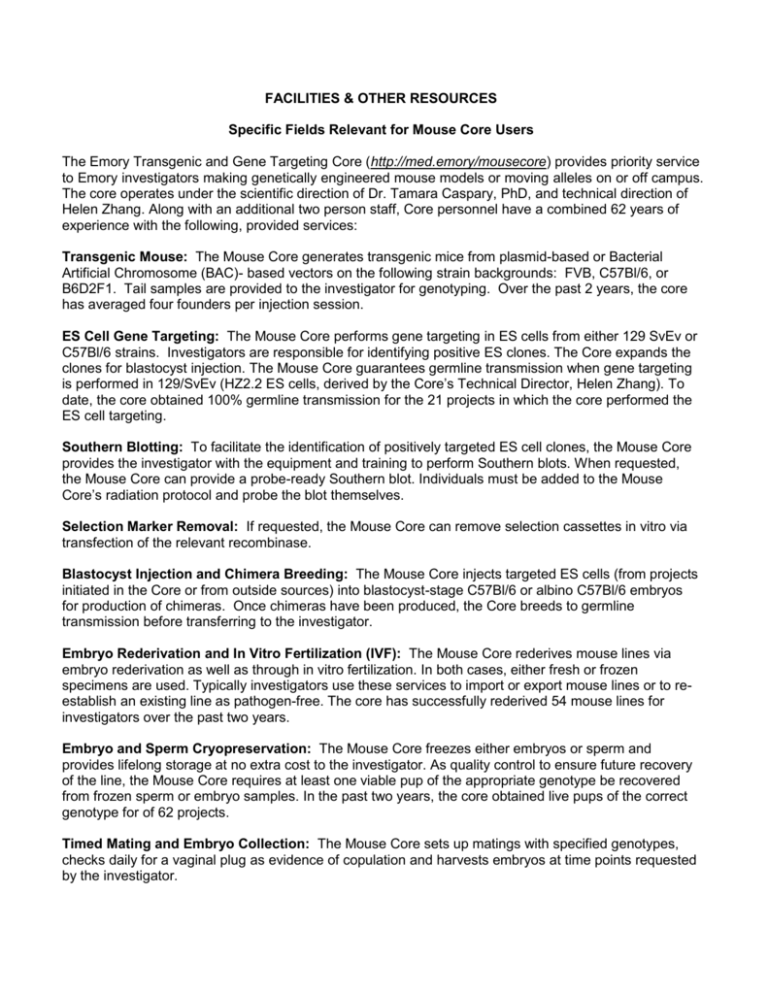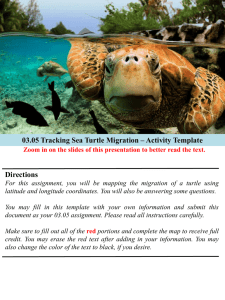Facilities & Other Resources - Emory Integrated Core Facilities
advertisement

FACILITIES & OTHER RESOURCES Specific Fields Relevant for Mouse Core Users The Emory Transgenic and Gene Targeting Core (http://med.emory/mousecore) provides priority service to Emory investigators making genetically engineered mouse models or moving alleles on or off campus. The core operates under the scientific direction of Dr. Tamara Caspary, PhD, and technical direction of Helen Zhang. Along with an additional two person staff, Core personnel have a combined 62 years of experience with the following, provided services: Transgenic Mouse: The Mouse Core generates transgenic mice from plasmid-based or Bacterial Artificial Chromosome (BAC)- based vectors on the following strain backgrounds: FVB, C57Bl/6, or B6D2F1. Tail samples are provided to the investigator for genotyping. Over the past 2 years, the core has averaged four founders per injection session. ES Cell Gene Targeting: The Mouse Core performs gene targeting in ES cells from either 129 SvEv or C57Bl/6 strains. Investigators are responsible for identifying positive ES clones. The Core expands the clones for blastocyst injection. The Mouse Core guarantees germline transmission when gene targeting is performed in 129/SvEv (HZ2.2 ES cells, derived by the Core’s Technical Director, Helen Zhang). To date, the core obtained 100% germline transmission for the 21 projects in which the core performed the ES cell targeting. Southern Blotting: To facilitate the identification of positively targeted ES cell clones, the Mouse Core provides the investigator with the equipment and training to perform Southern blots. When requested, the Mouse Core can provide a probe-ready Southern blot. Individuals must be added to the Mouse Core’s radiation protocol and probe the blot themselves. Selection Marker Removal: If requested, the Mouse Core can remove selection cassettes in vitro via transfection of the relevant recombinase. Blastocyst Injection and Chimera Breeding: The Mouse Core injects targeted ES cells (from projects initiated in the Core or from outside sources) into blastocyst-stage C57Bl/6 or albino C57Bl/6 embryos for production of chimeras. Once chimeras have been produced, the Core breeds to germline transmission before transferring to the investigator. Embryo Rederivation and In Vitro Fertilization (IVF): The Mouse Core rederives mouse lines via embryo rederivation as well as through in vitro fertilization. In both cases, either fresh or frozen specimens are used. Typically investigators use these services to import or export mouse lines or to reestablish an existing line as pathogen-free. The core has successfully rederived 54 mouse lines for investigators over the past two years. Embryo and Sperm Cryopreservation: The Mouse Core freezes either embryos or sperm and provides lifelong storage at no extra cost to the investigator. As quality control to ensure future recovery of the line, the Mouse Core requires at least one viable pup of the appropriate genotype be recovered from frozen sperm or embryo samples. In the past two years, the core obtained live pups of the correct genotype for of 62 projects. Timed Mating and Embryo Collection: The Mouse Core sets up matings with specified genotypes, checks daily for a vaginal plug as evidence of copulation and harvests embryos at time points requested by the investigator. Teratoma Injections: In collaboration with Emory’s induced pluripotent stem cell (iPSC) core and the Research Pathology Lab, the Mouse Core performs teratoma formation assays. Once the iPSC core derives a putative iPSC line (mouse or human), the Mouse Core injects the iPSCs into the flank, testes or the kidney capsule of an immunocompromised mouse, as selected by the Investigator. The mice are monitored and after 10 weeks, evaluated for formation of teratomas. The Mouse Core harvests the teratoma and the Research Pathology lab performs immunohistochemistry for markers of endoderm, mesoderm and ectoderm. Presence of all three layers indicates the iPSC line is bone fide. CRISPR/Cas9: The core is constantly striving to provide new services and is actively developing CRISPR/Cas9 as an injection service which we hope to launch by the end of the 2014 calendar year.






